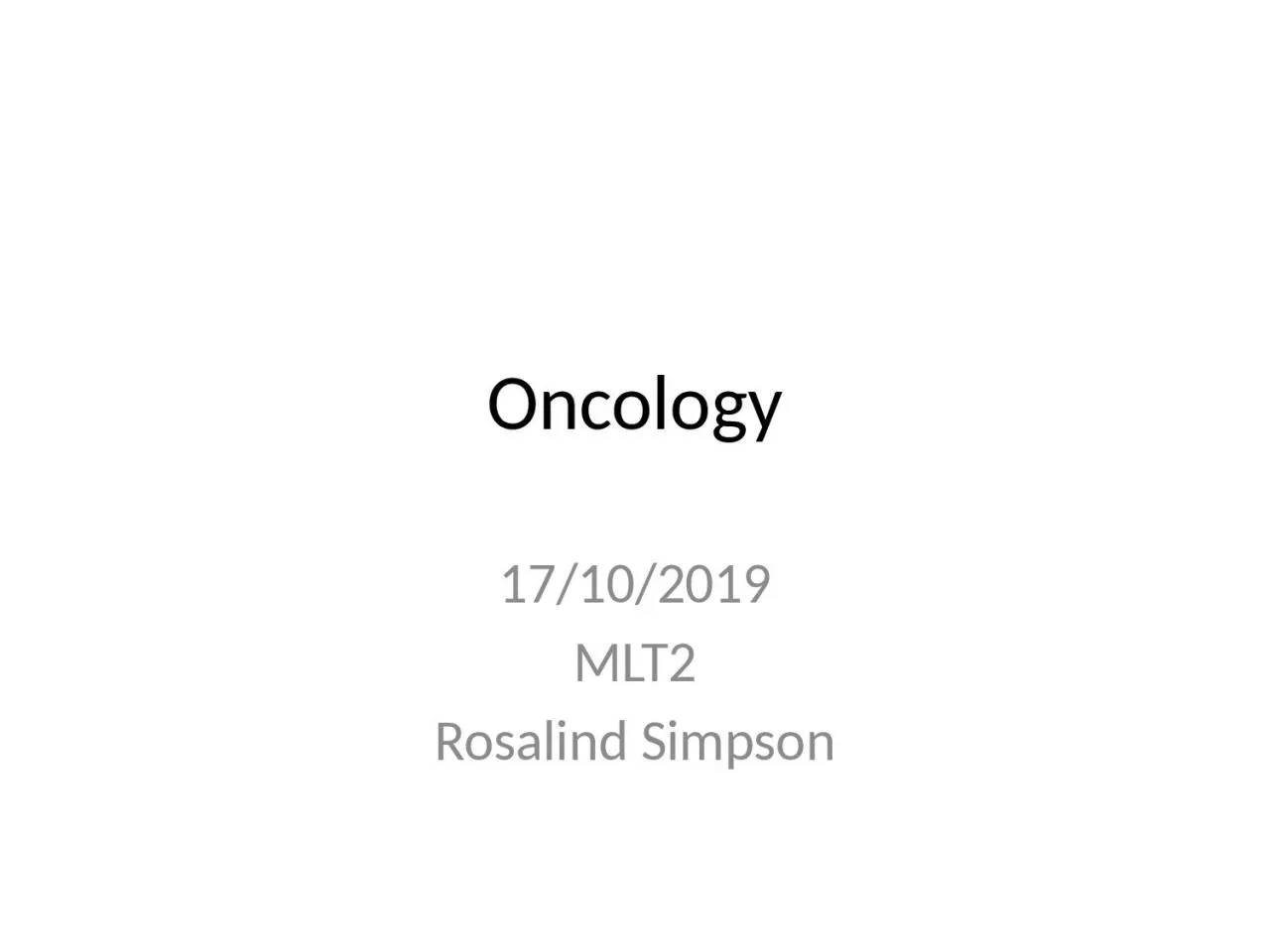

Rosalind Simpson Plan Pathology staging of common malignancies Oncological emergencies Screening theory and screening programmes Pain management and palliative care in terminal disease Breast ID: 935667
Download Presentation The PPT/PDF document "Oncology 17/10/2019 MLT2" is the property of its rightful owner. Permission is granted to download and print the materials on this web site for personal, non-commercial use only, and to display it on your personal computer provided you do not modify the materials and that you retain all copyright notices contained in the materials. By downloading content from our website, you accept the terms of this agreement.
Slide1
Oncology
17/10/2019
MLT2
Rosalind Simpson
Slide2Plan
Pathology + staging of common malignancies
Oncological emergencies
Screening theory and screening programmes
Pain management and palliative care in terminal disease
Slide3Breast
Slide4Breast
~8
0% ductal
~15% lobular
~5% other
eg
medullary
mucinous, papillary
Slide5Classification by histology
Oestrogen
+
progesterone
HER2 (human e
pidermal
growth factor
receptor 2)
Triple negative
Proliferative markers
eg
ki67
Slide6Oestrogen
rece
ptor
Premenopausal = Tamoxifen
SERM = antagonist at breast, agonist at bone
Postmenopausal = aromatase inhibitors
Block conversion of adrenal androgens to oestrogens in fatty tissues
Anastrozole
Slide7Her2
rece
ptor
Trastuzumab (aka
Herce
ptin
)
Humanized monoclonal antibody
Slide8Nomenclature of monoclonal antibodies
-
umab
=
hUMAn
-
zumab
= hUMAniZed
-
ximab
= x
= chi = chimeric
-
imab
=
primate
-
omab
=
mouse
MAB Monoclonal Anti Body
Slide9Ki67 + tri
ple
negative
Aggressive. Adjuvant chemo indicated
Ki67
positive tumours are
chemosensitive
Slide10Staging
Slide11Nottingham
Prognostic Index
tumour grade [1 – 3] + lymph node status [1 – 3] + 0.2 x tumour size [
cms
]
Result between 0 and 7
Less than 2.4 = same survival
>5.4 less than 20% 5 year survival
Slide12Slide13Lung
Slide14Lung
15% small cell lung cancer
Metastasise
early
Chemosensitive
but
poor prognosis
Can produce ACTH, SIADH, cause LEMS
85% non small cell
42% squamous
39% adenocarcinoma commonest in non smokers
8% large cell
7% carcinoid
Slide15Slide16Colorectal
Slide17Colorectal
Two thirds colon one third rectum
Adenocarcinomas that arise from
polyps
Slide18Slide19Slide20Prostate cancer
Adenocarcinoma
Multi-focal (different foci have different properties)
Mostly indolent but minority are aggressive
Metastasise
to bone
Slide21Presents
Bone pain, erectile dysfunction, lower back pain, lethargy, anorexia,
wt
loss,
haematuria
LUTS – less commonly
Raised or rising PSA – not particularly sensitive or specific
Hard and nodular prostate on DRE
Slide22Diagnosis +
gleason
grade
TRUS biopsy
10-12 cores taken
Commonest and second most common
tumour
patterns identifiedEach graded from 1 (normal tissue) to 5 (completely undifferentiatedSum themGet a number between 2 and 10Low grade = 6 or less, intermediate = 7, high grade = 8+
Slide23Goals of treatment
Radical = with curative intent
Palliative = to reduce symptoms/prolong life – WITHOUT curative intent
Adjuvant = alongside/after definitive (normally surgical therapies) – implies curative intent
Neo-adjuvant = before definitive treatment to eliminate
micrometastases
Slide24Goals of treatment
Watchful waiting = postponing palliative treatment
Active surveillance = postponing radical treatment and involves re-biopsy
Slide25Radical Therapy
External Beam Radiotherapy
Prostatectomy
Slide26Adjuvant therapies
Androgen withdrawal – surgery, LHRH agonist or LHRH antagonist
LHRH agonists
eg
gosrelin
Agonists can cause a flare which you can block with
bicalutaideLHRH antagonists eg cyproterone acetate
Slide27Also be ready for
melanoma
cervical
endometrial
bladder
kidney
liver
pancreas
Slide28Oncological emergencies
Tumour
lysis syndrome
S
pinal cord compression
SVC obstruction
Neutro
penic sepsisHy
percalcaemia
Slide29Tumour
Lysis Syndrome
The
abru
pt
release of large quantities of cellular components into the blood following rapid lysis of malignant cells
Slide30Who gets it
Cancers with large
tumour
bulk (more
tumour
to lyse)
Cancers that are very
chemosensitive (more of the
tumour
lyses at once)
Leukaemias
and
lym
phomas
especially aggressive lymphomas
Poor renal function (cannot clear the toxic cell contents)
Slide31What ha
ppens
Proteins are released ->
hyperuricaemia
Electrolytes that are more concentrated in the cells are released ->
hy
perphosphataemia
and
hyperkalaemia
The
phosphate complexes with calcium ->
hypocalcaemia
The uric acid and calcium
phosphate crystals deposit in the renal tubules ->
acute renal failure
Slide32Presentation
Weakness
Paralytic ileus -
Consti
pation
,
vomiting,
abdo
pain
Cardiac
arhythmias
- Palpitations, chest pain, collapse
Acute kidney injury - reduced UO, lethargy, nausea
Slide33Investigations
FBC
U+E - raised urea, raised creatinine (AKI(,
hy
perkalaemia
Serum LDH - high
Serum
phosphate - highSerum calcium - low
Serum
urate
- high
Slide34Management
Awareness,
identification of high risk
patients,
implementation of prophylaxis,
monitoring patient during chemotherapy
Starting active treatment when necessary
Slide35Prevention for high risk patients
IV fluids
,
Rasburicase
: recombinant urate oxidase -
catalyses
the oxidation of uric acid to more soluble allantoin
, Allo
purinol
: xanthine oxidase inhibitor - blocks conversion of
xanthines
to uric acid
Slide36Active treatment
Vigourous
hydration
Correct
hy
perkalaemia
Protect the myocardium with 10mls of 10% calcium gluconateDrive
potassium into cells with 10 units of rapid acting insulin and 50mls of 50% glucose
Salbutamol neb
Remove the potassium with oral calcium
resonium
Slide37Active treatment
Rasburicase
(
sto
p allopurinol)
Acetazolomide
= alkalinize urine make uric acid more soluble
Phosphate bindersIf above fails
dialyse
Slide38Neutro
penic
sepsis
Neutro
penia
of ** AND a fever >38 OR other signs or symptoms suggestive of sepsis
Neutro
penia =
neuts
<1
Nice guidance = <.5
Some hospitals = <.7 to <1
Slide39At risk of
neutro
penic
sepsis
Current or recent anticancer treatment
Most commonly chemo for blood cancers
But also lung, breast, ovarian, colorectal
Slide40Slide41Slide42Investigations
FBC !!!
Identify source or
pathogen = CXR, Urine M C + S, blood culture
Slide43Treatment
ABCDE
Sepsis six
IMMEDIATE commencement of
em
piric
abx
DO NOT wait for the
fbc
NICE
piperacillin with tazobactam
Some hos
pital
guidelines add gentamicin
Slide44prevention
If considered high risk = fluroquinolone
monothera
py
NOT recommended routinely by NICE but
im
portant
to know about = GCSF